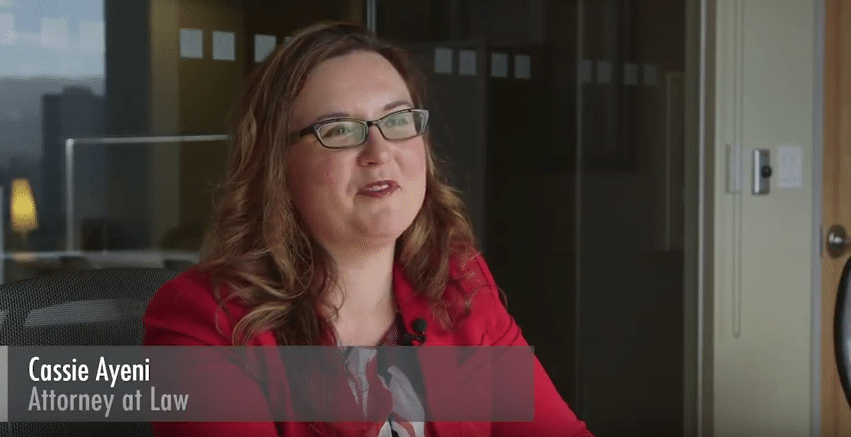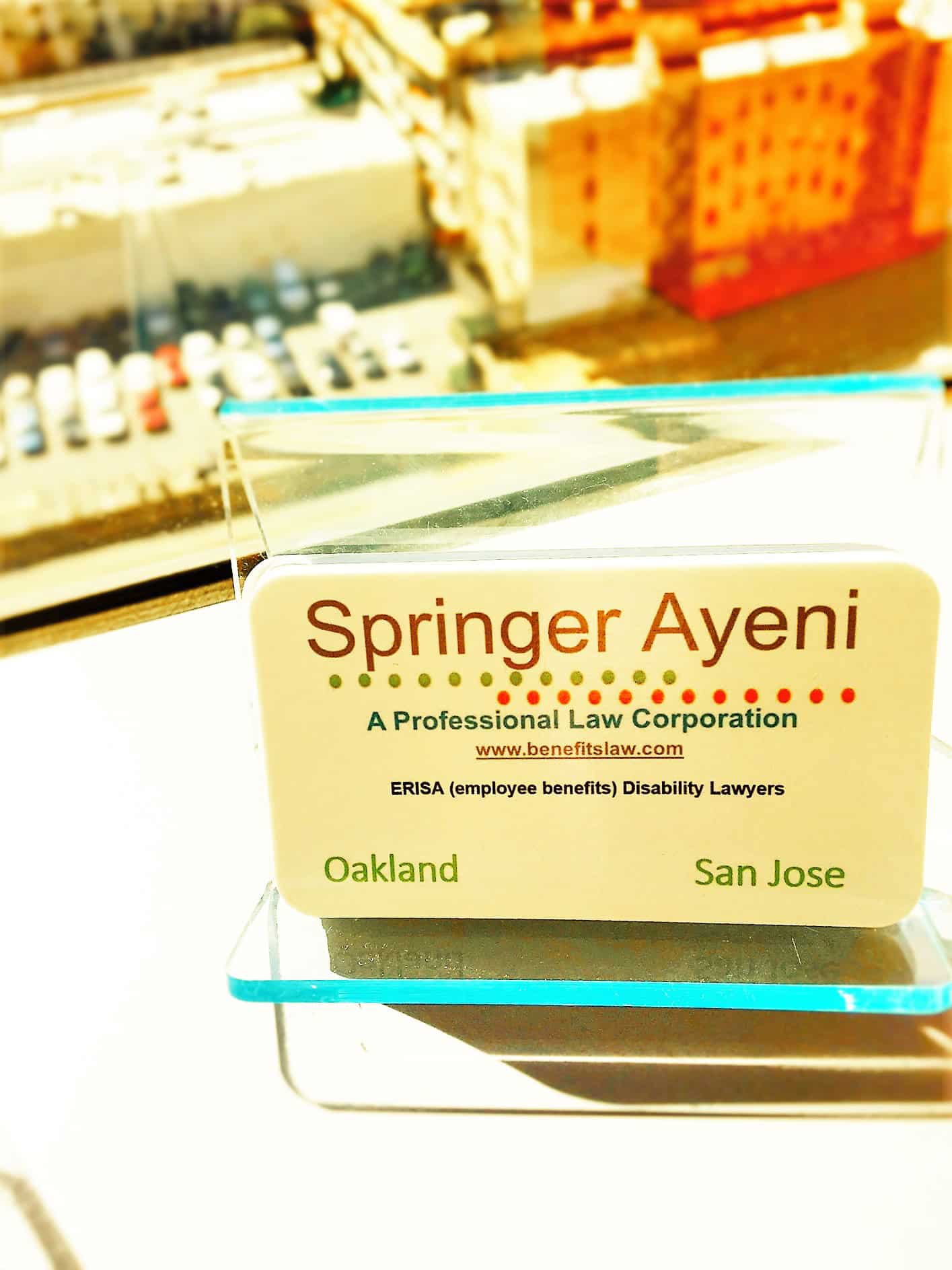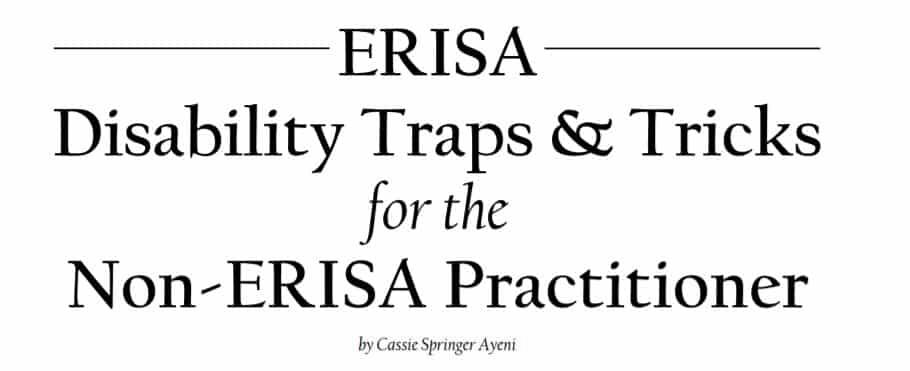ERISA Basics National Institute 6-Part Webinar Series
June 15th – 17th 2020, I will be speaking on two Employee Benefits Claims panels at the American Bar Association Joint Committee on Employee Benefits sponsored – ERISA Basics National Institute 6-Part Webinar Series. On the panels, I will present: 1) Statutory Overview and 2) Benefit Claims: Administrative Procedures & Litigation. The great news is that – it is virtual! Now you can join in without the burden of travel! #silverlinings. I look forward to the discussions, questions, and sharing of insights/ideas.
For more, see event details: https://www.americanbar.org/events-cle/mtg/web/394126606/
Or contact: Cassie Springer Ayeni, President of Springer Ayeni, A Professional Law Corporation @ www.benefitslaw.com
#JCEB #EBC #ABA #ERISA #Employeedisabilitybenefits #disablity #ERISAlawyer #Superlawyer #Disabilityclaims #Disabilityappeals #Longtermdisability #ERISAlitigator #ERISAbayarea #Disabilitylawyer #Employeebenefitslawyer #ERISAlawfirm #SpringerAyeni #benefitslaw #presenter

Cassie Springer Ayeni Named SuperLawyer 6 Years in a Row
For the 6th consecutive year, Cassie Springer Ayeni has been named a SuperLawyers Top 50 Women Attorney for Northern California, and a Top 100 Attorney for the 5th consecutive year. She has been named to the SuperLawyers list for her expertise in employee benefits for 8 consecutive years.
Read More
Incoming chair message to Employee Benefits Committee
So much has happened in these few months since I wrote this message to the Employee Benefits Committee as one of its incoming co-chairs. Since then, we had a successful midwinter meeting in Rancho Mirage, but none of us knew that would likely be our last travel occasion for the foreseeable future. Here’s a blast from the near past, which feels like a lifetime ago:
Read More
Here’s a blast from the near past, which feels like a lifetime ago
So much has happened in these few months since I wrote this message to the Employee Benefits Committee as one of its incoming co-chairs. Since then, we had a successful midwinter meeting in Rancho Mirage, but none of us knew that would likely be our last travel occasion for the foreseeable future. Here’s a blast from the near past, which feels like a lifetime ago:
Read More
Springer Ayeni Wins Disability Case Against Aetna
Even in tough times, we are grateful for the hard-working judges and court personnel who continue to decide cases and keep the wheels of justice turning. On March 24, 2020, the attorneys at Springer Ayeni achieved a victory for our client, a man disabled by shoulder pain and denied disability benefits by Aetna Life Insurance Company. Judge Chesney of the Northern District of California ordered benefits paid for Mr. Shaikh’s own occupation and remanded for a determination on the amount. The Court found that Aetna “overly focused” on objective medical evidence and “essentially disregarded” Mr. Shaikh’s credible complaints of pain. Springer Ayeni is now pursuing attorney fees against Aetna. https://law.justia.com/cases/federal/district-courts/california/candce/3:2018cv04394/329565/46/
Read More
A Conversation with Attorney Cassie Springer Ayeni
Q: When did you know you would pursue a career in the legal field?
CSA: As early as junior high or high school, I felt the need to advocate for others, to make a point to stand up for the kids who were being bullied or ostracized. I also realized around the same time that I truly enjoyed writing, reasoning, and debating. The law seemed a natural fit: I could use my skills to make a palpable difference in people’s lives. I had settled on a career in law by the time I was 16 and never looked back.
Q: Can you explain what types of cases an ERISA Attorney handles and why you chose this area of law?
CSA: I primarily help people with their employer-sponsored disability benefit claims. ERISA governs all private employer benefit plans, not just pension plans. Many employers provide disability benefit plans in addition to health and pension benefits. In fact, 65% of ERISA litigation is over denied disability benefit claims. The plans are often insured, and clients typically come to me after they stop working, apply for disability benefits to the insurance company, and are denied. I then step in to try to get their disability benefit income restored while they focus on their health.
Q: What is your approach or philosophy to winning or representing a case?
CSA: I lead with kindness. I want to understand truly what my clients have gone through medically, economically, and emotionally to get to this point in their lives, and how I can help. In representing a client, I am there for that person: I am responsive and listen with an open heart. I believe this the secret to winning a case as well – if I am doing my job right, I am painting a picture of the person and the case to help the court appreciate why my client is deserving of their disability benefits. I have the paintbrush and paint ready because I have spent months getting to know my clients and researching the law. And I also aim to be the best-prepared lawyer in the room with the most compelling brief … that helps too.
Q: If we interviewed all your past clients … what is “one” common word that comes up when they describe working with your law firm?
CSA: Compassion
Q: What are some of the most popular topics you are asked to lecture on?
CSA: I speak frequently on ERISA topics, especially in my current role as the co-chair of the ABA’s Employee Benefits Committee. I love presenting to newer attorneys about the fundamentals of ERISA litigation, because I am eager to energize attorneys about how engaging ERISA work is. ERISA is fun! The law is always evolving, providing constant intellectual stimulation, and practicing ERISA law is also a great way to help people in need. I also enjoy speaking to women about re-defining what it means to be a successful litigator, and how to challenge traditional law firm standards to achieve a better work-life balance.
Q: What advice would you give to young women who want to pursue a career as an Attorney?
CSA: Any woman who wants to pursue a career as an attorney should make sure that her potential work environment values diversity and inclusion, fosters a sense of belonging, and creates opportunities for women at every turn. If she is unable to find that environment, she should open her own law firm and create those opportunities herself.
Q: How do you maintain a work/life balance?
CSA: Being the owner of my firm allows me to make up the rules: I look to the best practices of progressive companies and pick policies that I believe are imperative to work/life balance for everyone. I figure that everything I need to raise four children and work full-time as an attorney is what everyone at my firm needs too. I offer unlimited PTO, great benefits, four months of fully paid maternity leave, the ability to bring children in to work as needed (in fact I have brought each of my babies into work until they needed another environment), the ability to work from home, and a practical approach to parenting … like closing the office on Halloween and Valentine’s Day so that we can all attend class parties without rushing to or from work. I, of course, avail myself of each of these policies, which is why I created them in the first place. That’s not to say that I don’t wake up early to work for a bit so that I can focus fully on my kids to take them to school, or grab a few hours on the weekend to pound out a brief, but family always comes first, for me and for everyone who works at Springer Ayeni.
Q: What’s one lesson you’ve learned in your career that you can share with our audience?
CSA: I have always learned to be myself. If you are authentic, you are compelling as an advocate and a counselor: you listen and communicate better when you are not spending energy on worrying about how you should come across. I also believe in the power of preparation. If you are committed to doing your best and preparing your utmost, then even a negative outcome cannot be met with regret, but a positive outcome is much more likely. And if you’re nervous before a court appearance or speaking engagement, just take a breath and realize that even in a worst-case scenario, you will survive and move forward … we all do.
Q: What are some of the challenges you feel women face today?
CSA: Looking at women lawyers only, there is much progress to be made. As Joan Williams at the UC Hastings Center for WorkLife Law has analyzed convincingly, women lawyers (and women in other fields too) are asked to “prove it,” then “prove it again.” In other words, women need to do the job before getting the promotion, whereas men are promoted based on potential. This is a major obstacle to women’s promotion and needs to be addressed systematically.
Five Things About Cassie Springer Ayeni
1. If you could talk to one famous person past or present, who would it be and why?
There are so many! But if I had to pick one it would be Harriet Tubman – her courage and vision even in the face of medical problems were and are awe-inspiring.
2. What’s your favorite holiday? Why?
Valentine’s Day! I don’t view it as just a romantic holiday, but as a day to express to those around you how much you care.
3. If you were a superhero, what would your special powers be?
Time-traveling. That would be magical!
4. What app can’t you live without?
Facebook – it has allowed me to make great connections with other lawyer moms – lawmas!
5. Favorite food to eat?
Strawberries. Now, then, forever, and always.
See the interview at https://bayareawomenmag.com/news/view/11665/Her_Firms_Achievements_-_Results_are_Measured_by_the_Satisfaction_of_Her_Clients_A_Conversation_with_Attorney_Cassie_Springer_Ayeni
Read MoreLong Term Disability (LTD): The Hidden Gem in Your Benefits Package

What is an LTD benefit?
Most long-term disability benefits are insurance policies that provide about 50-67% of your base income should you become disabled. What does it mean to be disabled? It will be defined in the policy, but typically it is defined as the inability to perform the material duties of your occupation due to illness or injury. After some time, usually 24 months, the definition of “disability” may change to the inability to perform the material duties of any occupation (taking into account your education, training, and prior income level) due to illness or injury. Mental illness disabilities are usually limited to 24 months of benefits in total.
Many illnesses or injuries can qualify you for a disability benefit. Examples include back, neck, knee, or upper extremity pain, migraines, fibromyalgia, cancer and its consequences, HIV/AIDS, pulmonary dysfunction, cognitive impairment, neurological conditions like Parkinson’s Disease, or chronic pain conditions. Disabilities do not just strike the elderly; my clients range from ages 29-67, with most of them being in their 50s. Yet they all have one thing in common: none were expecting to have to stop working before retirement age due to a medical problem.
Who has an LTD benefit plan?
Most professionals work for employers that provide disability benefit plans. These disability insurance policies have relatively low premiums, so employers often provide disability insurance to their employees as a matter of course. If you work for an employer that provides professional, medical, or technology services you are a prime example of someone who probably has a disability benefit plan through your employer. For example, I frequently represent doctors, nurses, and other medical professionals, lawyers, engineers, project managers, programmers, financial services professionals, executive directors, and even insurance claims adjusters. To see if you have disability coverage, look up your original benefits package or examine what benefits you elected. You can also look up your employer’s IRS Form 5500 filing, which should include details on ERISA retirement and “welfare” benefits such as health, disability, and life insurance benefit plans. ERISA is the law that governs almost all employer-sponsored benefits.
What to do if you need to apply for LTD benefits?
If your doctor has advised you to stop working, please verify whether your employer has an LTD plan or give me a call and I’ll help you figure it out. There are other benefits that might be available to you as well (state disability, Social Security, workers’ compensation, etc.), which I can outline for you. If your employer does have an LTD plan, bear in mind that the reason you stop working has to be because of your disability for you to have coverage and make a successful LTD claim. In some states, including California, late applications can still be accepted as long as the insurer is not harmed by your late claim notice. Typically, your last date of work is also your first date of disability. If you are laid off for performance reasons that are actually related to your disability, you may still have a good LTD claim, but call me to help you analyze it. (You may also have a disability discrimination claim.) If you 1) have an employer-sponsored LTD plan, 2) need to stop working because of a medical condition, and 3) your doctor has advised you to stop working and will fill out a form on your behalf, you should strongly consider applying for LTD benefits. These benefits may be available until age 65 or 67, so do not shy away from making an application! However, there are many traps along the road of applying for and receiving LTD insurance benefits, so feel free to reach out to me if you have any questions about whether you should apply or how to maximize your chances of receiving benefits.

#LTD benefits
My Patient Needs to Stop Work … Now What?
By Cassie Springer Ayeni, Disability and Life Insurance Benefits Lawyer
with Springer Ayeni, A Professional Law Corporation
cassie@benefitslaw.com . www.benefitslaw.com
It happens: your patient comes to an appointment, and after months or years of “getting by” at work, despite a degenerative or chronic condition, it is clear to you that those days are over. You recommend that for her health, she stop working. Now what?
What your patient now faces is a host of forms and requests from insurance companies and the government to ensure that she has some income even though she’s not working anymore. Besides savings (and it is unheard of for someone in the prime of her working life to have sufficient savings to live decently for the rest of her days), income sources for people with disabilities include:
- Employee benefit plans (short-term disability then long-term disability). Long-term disability usually starts after 6 months and can last until retirement age.
- Private disability insurance plans (also lasting until retirement age).
- State disability insurance that usually last for a year (like California’s EDD).
- Social Security Disability Benefits (available after being disabled for a year and lasting through retirement age).
To qualify for any of these benefits, the #1 thing that a patient needs is help and support from the doctor. Without it, she won’t be approved; and if support wanes in the future, the insurance companies won’t hesitate to cut off her benefits. Here’s what you can do to help ensure that your patient receives disability benefit income on time and without hiccups:
Medical Records
- Document the reason why the patient is disabled in the medical records. List as many objective findings as are available (ROM, atrophy, MRIs, visual findings, etc.), including your objective observations.
- Document in the medical records whether the patient’s complaints of pain, fatigue, or other disabling symptoms are credible.
- If the patient has worked with the condition, answer the question in the medical records of “why now?” Why was she able to work before with the condition but suddenly cannot? Has there been a worsening of symptoms? Do you feel that her best chance of getting better is by resting for a bit at home? Document your rationale in the medical records.
- When the patient gets approved for benefits, keep track of the symptoms in regularly scheduled check-ups; insurance companies request updated medical records every 6-12 months.
Forms Requests
- Be sure to complete and return forms as quickly as possible. Although it is tempting to punt the form-filling to a secretary, it is more credible when completed by you.
- If there are any boxes on the forms that not applicable to your patient, just write N/A or rephrase the question so it makes sense for your patient
- Beware of traps in the questions: If a question states “how often can your patient work? 3 hours, 6, hours, or 8 hours a day,” but you feel your patient could only work 1 hour a day with breaks and unreliable, don’t check a box; just write your true response.
Working with the Lawyers
- Thankfully, with the increasing popularity of medical-legal alliances, most physicians and lawyers now truly comprehend their shared interest in the patient’s well-being, and working together on the insurance requests helps for seamless communications with the insurer. A patient about to go on disability can benefit from a quick call to a benefits attorney to make sure that every “I” is dotted and “t” is crossed.
- A patient whose disability benefits claim has been denied should never attempt to appeal on her own without the benefit of some legal advice.
- Also, even when a patient is approved for benefits, don’t hesitate to ask her lawyer for help understanding the forms; the lawyer and the patient will appreciate it more than you know.
Cassie Springer Ayeni is the President and Founder of Springer Ayeni, A Professional Law Corporation, in Oakland, CA, where she focuses on ERISA disability and life insurance cases. She can be reached atcassie@benefitslaw.com or www.benefitslaw.com
Read More
ERISA Disability Traps & Tricks for the Non-ERISA Practitioner
By Cassie Springer Ayeni, President Springer Ayeni, A Professional Law Corporation
The Employee Retirement Income Security Act, better known as ERISA, is referred to by at least one judge as “Everything Ridiculous Imagined Since Adam.” Florence Nightingale Nursing Service, Inc. v. Blue Cross and Blue Shield, .832 F. Supp. 1456, 1457 (N.D. Ala. 1993), affirmed, 41 F.2d 1476 (11th Cir. 1995) (Acker, J.). It gets its sordid reputation from its limited remedies, roots in trust law, and limited discovery rules. Yet ERISA is so vast that every lawyer should know a little bit about it.
Most practitioners know that ERISA covers employer-sponsored retirement plans, yet few realize that with minor exceptions[1] it also governs all employer-sponsored health plans, disability benefit plans, and life insurance plans. 29 U.S.C. § 1002. Of these categories of ERISA litigation, disability benefit lawsuits comprise 64.5% of ERISA litigation, health care accounts for 14.4% or ERISA litigation, and pension just 9.3%. Anderson, S., ERISA Benefits Litigation: An Empirical Picture, 28 ABA J. Lab. & Emp. L. 1 (2012) at p. 7. Why is that? Though ERISA was originally designed to protect pension claims, more and more employers are eliminating traditional pension plans for employees or have outsourced to fiduciaries, and ERISA provides limited relief for breaches of fiduciary duties. Health claims are notoriously mishandled (we all probably have our own examples of that!), yet if a plaintiff brings an ERISA claim for denied health benefits, the remedy is that the medical provider gets reimbursed, and there are no punitive, compensatory, or consequential damages available to the plaintiff. Disability benefit claims, however, are another story. If a worker with an employer-sponsored disability benefit plan files a claim for benefits, that claim is typically administered and paid for by an insurance company. And because these insurers have a financial conflict of interest, many disability benefit claims are denied despite the claimant’s doctor’s decision that the claimant should stop working. The remedy under ERISA is payment of the disability benefits through the date of judgment, and benefits can potentially continue until retirement age. In other words, disability benefits are worth a lot over the claimant’s working lifetime. That’s why a little ERISA knowledge comes in handy for any practitioner.
Screening for ERISA
First, in screening these calls from potential clients, be aware that some issue spotting will be incredibly valuable, as most individuals do not even realize that their claim for disability benefits is governed by ERISA. Most individuals call with an assumption that the appropriate area of expertise is disability discrimination, workers’ compensation, Social Security disability, or California state disability insurance. But if the employer offered a disability plan, it is ERISA help they need.
TRAP #1: Assuming that the potential client knows what kind of attorney she needs for her disability issues. TRICK #1: Simply ask “did your employer offer a disability benefit plan?” If so, ERISA will probably govern.
Severance Waivers of ERISA Claims
Second, many people with disabilities may contemplate quitting their job for performance issues or have already been told they will be terminated. If they are getting close to retirement age, they may assume that an early retirement is the honorable way to exit the job. The disabled worker may be offered separation or severance pay, but many standard separation or severance agreements actually waive all claims under ERISA! If someone could potentially obtain a monthly disability benefit until retirement age through their disability benefit plan, this is an extremely valuable benefit to waive in exchange for severance. Indeed, the prudent plaintiff’s attorney should routinely screen for disability if negotiating severance, as no one would want to give the green light for waiving hundreds of thousands of dollars in disability benefits in exchange for a little severance.
TRAP #2: Failing to edit out a waiver of ERISA claims. TRICK #2: Carve out any claims for disability benefits, health benefits, or pension benefits that might arise under ERISA. An example of a good carve out is: “However, the following claims are specifically and expressly excluded from the foregoing Release: (i) health insurance benefits under ERISA or the Consolidated Omnibus Budget Reconciliation Act (COBRA); (ii) claims with respect to benefits, including short- and long-term disability benefit benefits, under a welfare benefit plan governed by the Employee Retirement Income Security Act (ERISA); or (iii) claims with respect to vested benefits under a retirement plan governed by ERISA.” Most employers understand the practicality of this, particularly because such claims are usually (but not always) filed against the disability insurer, not the employer.
Strict ERISA Deadlines
Third, although it is best for the potential client to find an ERISA attorney before making the decision to apply for disability benefits, most do not. Rather, most potential clients try to find legal help only after the insurer has denied the claim for disability benefits. At that point, ERISA’s Regulations prescribe a 180-day period for appealing the denied benefit claim. This process MUST be completed or else the claimant loses the right to file suit, also known as “failure to exhaust administrative remedies.”
TRAP #3: Failing to submit an appeal of an adverse disability benefit decision within 180 days of receipt of that decision. TRICK #3: Don’t miss this deadline! But if all else fails, immediately call the insurer to request an extension. ERISA’s regulations allow for “at least” 180 days, but it is up to the insurer to allow an extension. If granted over the phone, immediately follow it up in writing and indicate a date by which the claimant will submit the appeal.
Evidence in the Appeal
Fourth, although filing a hasty appeal is all that is necessary to preserve the ability to file a lawsuit, a scant appeal letter will not win the appeal, nor will it enable an ERISA practitioner to take the case for litigation. ERISA disability litigation is limited to the factual evidence presented in the aforementioned administrative appeal. Once in court, in all but rare circumstances, there will be no depositions, further medical records, or opportunities for direct or cross-examination. And there are also no jury trials. So if you help someone with their disability benefit appeal, please be sure to include all evidence necessary to win the case down the road.
TRAP #4: Assuming that there will be a chance in court to put in more evidence supporting the disability claim. TRICK #4: Throw in everything but the kitchen sink into the appeal! If you think the evidence might be useful in litigation, put it into the appeal. Declarations from the client, friends, family, medical providers, and colleagues, as well as all relevant medical records and expert reports, are key to submit in the appeal of a denied claim.
Filing an ERISA or ERISA-Related Claim
Finally, if you do decide to litigate an ERISA claim, be aware that these claims must be brought in federal court or you will face removal of the ERISA claims and all claims related to the ERISA claims. With limited exceptions, if you are bringing state law claims and ERISA claims, ERISA will preempt those state law claims.[2]
TRAP # 5: Failing to separate any state law claims from ERISA claims. TRICK # 5: Don’t even mention ERISA or other employee benefits or benefit-related remedies in your state law complaint. Leave the ERISA claims alone and litigate those separately as ERISA claims in federal court, or face removal.
TRICK #6: Give me a call. I’m an ERISA nerd and I’m happy to field your ERISA questions! 510-926-6768 Option1, or cassie@benefitslaw.com
Cassie Springer Ayeni is the President of Springer Ayeni, A Professional Law Corporation, in Oakland, CA, where she focuses on ERISA disability and life insurance cases. She can be reached at cassie@benefitslaw.com or www.benefitslaw.com
[1] Those exceptions are for public employees (anyone who works for the government such as teachers, legislators, public safety officers, etc.), and “church plans,” (anyone employed, even tangentially, by a religious organization including those who work at Catholic hospitals).
[2] ERISA’s “savings clause” provision saves from preemption any law that regulates insurance, banking, or securities. ERISA § 514(b)(2)(A). An example of the application of the savings clause is in California’s “notice prejudice” rule, which provides that claims can proceed even where there is late notice unless the insurer is prejudiced by the late notice. Because this is a law that regulates insurance and does not provide a remedy that conflicts with ERISA, the law is not preempted. UNUM Life Ins. Co. of Am. v. Ward, 526 U.S. 358, 373, 119 S. Ct. 1380, 1389, 143 L. Ed. 2d 462 (1999).
Read More
How to Apply for Long-Term Disability When You Stop Work
By Cassie Springer Ayeni
You never thought it would happen.
You thought you would work until retirement or beyond, but then along came your vestibular disorder. Now, focusing on a computer screen is a challenge; someone has to drive you to work; walking is a safety hazard; and your concentration is not what it used to be. All of these symptoms can interfere with your ability to do the material duties of your occupation, and can make an attempt to get through a workday exhausting and frustrating as you struggle to complete tasks that used to be easy for you. You
see your doctor and she tells you the time has come to stop working due to your disability. Now what? How will you live without your income? Here are some options and a plan:THERE ARE SEVERAL SOURCES FOR DISABILITY BENEFITS Besides savings (and it is almost unheard of for someone in the prime of her
working life to have sufficient savings to live decently for the rest of her days), income sources for people with disabilities include:
1.Short-term disability insurance benefits through your employer (these usually last for 6 months).
2.Long-term disability insurance benefits through your employer (these usually start after 6 months and can last until retirement age).
3.Private disability insurance plans (insurance you purchased for yourself that can last through retirement age or beyond).
4.State disability insurance (usually lasts for a year, such as through California’s Employee DevelopmentDepartment “EDD”).
5.Social Security Disability benefits (SSDI) (available after being disabled for 6 months and lasting through retirement age).
6.Workers’ Compensation benefits (if your disability is due to a work-related injury).
In this article we will focus on the first two of these income sources: short- and long-term disability benefit plans offered by your employer. (See VEDA’s other articles on how to apply for SSDI.)Many employers offer group disabilityplans to their employees because the premiums are low and they can be a huge benefit to employees struck with a disability, whether short- or long-term. These benefits are usually paid by insurance companies such as Unum MetLife, Hartford, Principal, Standard, Cigna/Lina, Guardian, Sun Life, and others.A complex area of law called ERISA (the Employee Retirement Income Security Act) governs these employee benefit plans, even though you apply to an insurance company for payment of the benefits. Under ERISA, there are technical rules governing timelines for the insurance company to decide whether to pay your claim. It is a good idea for you to get help with your disability application and, of course, with an appeal of any denials.
Important Tip: Even though you have a disability plan through your employer, you can still apply for all of the other disability benefits listed
above. However, the benefits are usually coordinated so that you only receive a fixed percentage of your salary altogether, usually 2/3 of yourprevious income up to a maximum benefit per month.
YOUR DOCTOR’S ROLE
Many people with vestibular disorders have a long-standing relationship with a supportive doctor. This relationship is instrumental to getting your disability benefit claims approved. Please make sure that your doctor knows how important it is that she fills out forms promptly so that your income stream can continue while you are not working. Here are some key tips for the “Attending Physician Statements” that you submit to the insurance company.
Tip #1:
Your doctor should answer the question “why is the patient disabled now?” especially if you have been struggling to work while symptomatic fora while. Did it worsen? Have your attempts to keep working caused a decrease in your performance? Is the fatigue from managing your symptoms getting the best of you, causing you to nap during the day? Are the symptoms interfering with your ability to perform the activities of daily living, such as preparing meals? Ask your doctor to be specific and make sure this is in your medical record.
Tip # 2:
One of the areas of misunderstanding with “invisible disabilities” like vestibular disorders is that a successful claim must depend on your report of “subjective” symptoms in addition to any objective tests. For the subjective symptoms to be deemed reliable by an insurance company, your
doctor should point out that you are credible in your symptom reporting. When your doctor notes this, it helps prevent the insurance company from doubting your credibility, an unfortunately common reality when insurance companies are looking for a way to cut costs. A good way to keep track of these symptoms is by keeping a log to share with your doctor: when you are nauseous or have a headache or a bout with vertigo, write it down in a log with a symbol for each symptom, then bring the log to every medical appointment.
Tip # 3:
If you have symptoms that can be objectively documented by testing, please get those tests done as soon as possible. For example, if you have concentration or other cognitive difficulties, ask for a referral for a neuropsychological examination, which provides objective evidence of those
symptoms.
Tip # 4:
Regularly schedule check-ups. Even if you have been relatively stable, it is a good idea to see your doctor at least every 6-12 months. This helps demonstrate to the insurance company that you are under the regular care of an attending physician. Insurance companies typically request medical records every 6-12 months.
Tip # 5:
If you don’t already have an ERISA lawyer, you might want to check in with one now. Your lawyer can work with your doctor to get the forms filled out the right way the first time.SUBMITTING THE APPLICATION Finally, your doctor has told you that resting without working is in the best interest of your health. You have agreed and have decided to apply for benefits.
Here is a checklist:
1.Request the short – and long-term disability application forms from your Human Resources (HR) department.
2.Request a copy of the short- and long-term disability policies from HR.
3.Take a stab at filling out the application forms, but do not feel limited to the boxes on the forms. If you need extra space, include an addendum. If the question on the form doesn’t really apply to you, modify the question and answer tostate what needs to be said about why you are disabled.
4.Make sure that your employer knows they will have to fill out a form verifying your income and job duties.
5.If it’s too overwhelming, ask an ERISA attorney to check your work to make sure that your application gives you the best shot at success.
6.If your application is denied, you should never attempt to appel on your own without the benefit of some legal advice.





